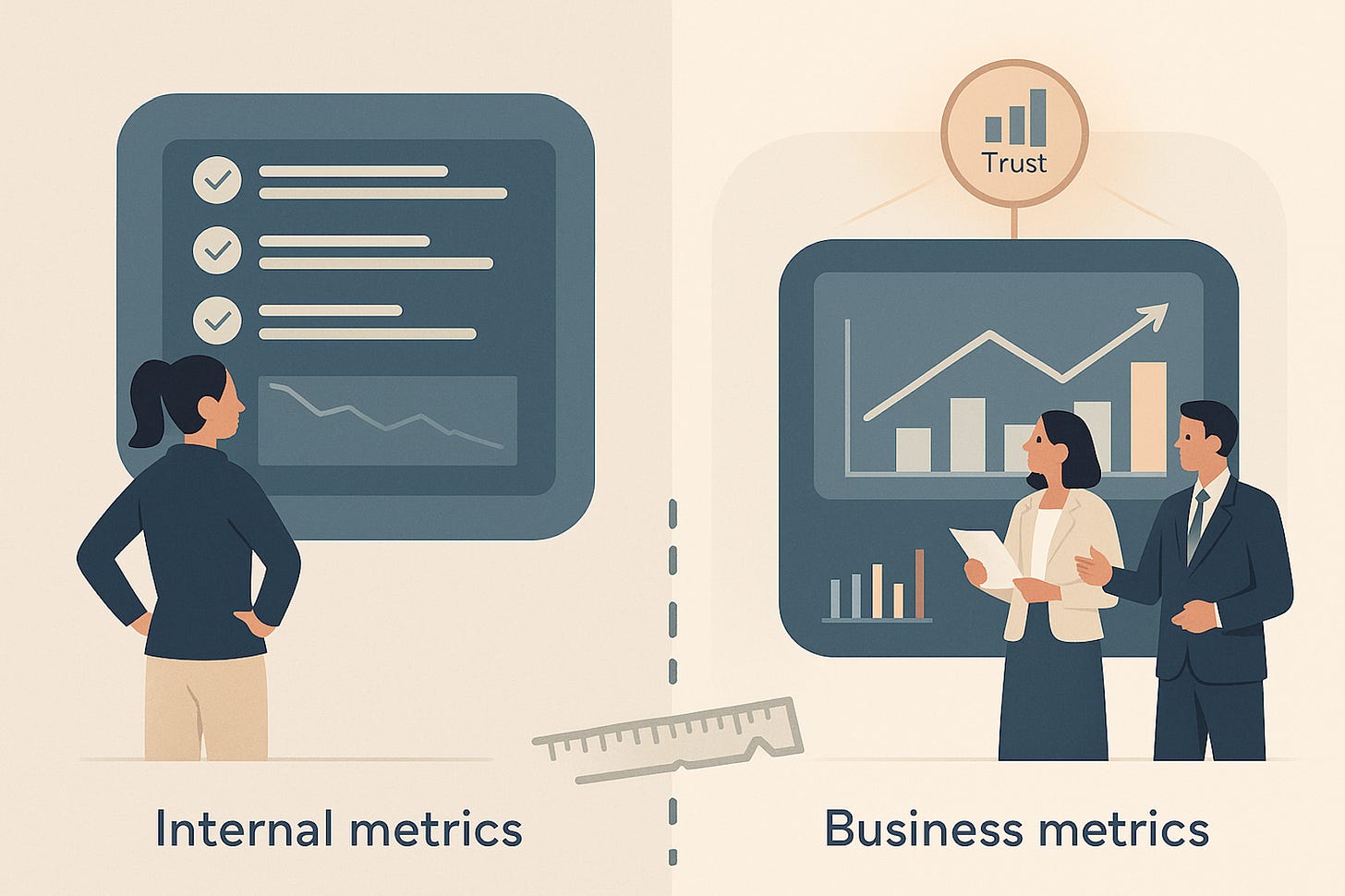Rule 4.2: From Internal Metrics to Business Metrics
Rule 1: You Don’t Talk About Trust
Rule 2: Master the Motion before Selling the Vision
Rule 3: If Someone Doubts, Hesitates, or Questions, Bring Them Closer
Rule 4.1: From Service to Product Thinking
Rule 4.2: From Internal Metrics to Business Metrics
The Second Shift: From Internal Metrics to Business Metrics
Trust teams struggle for relevance because they measure the wrong things. They track security incidents, compliance scores, and policy observance: all internally focused metrics that tell executives nothing about whether trust is helping the business win. CFOs and CROs prioritize revenue impact, not operational security metrics like phishing simulations or compliance scores. Executives do not budget for effort. They budget for outcomes: deal velocity, revenue retention, competitive differentiation, and enterprise valuation. Until trust teams reframe their measurement systems around these business metrics, they will continue to be treated as cost centers, struggling to justify investment while the rest of the business prioritizes initiatives that contribute to growth and market expansion.
This shift is not about adding more data to existing dashboards. It is about abandoning the entire IT-inherited mindset that defines trust success in operational terms. For too long, data protection professionals have assumed that their contributions are self-evident, that executives should inherently understand the importance of trust. This is a mistake. If trust does not appear in financial models and strategic planning discussions, it does not exist in decision-making frameworks. The way forward is not to demand that executives care more about trust but to translate trust into terms that already matter to them.
The failure of IT and security metrics has made this shift inevitable. Compliance reports tell executives nothing about whether market stakeholders perceive the company as trustworthy. Incident response times do not explain whether trust accelerates or slows enterprise deal cycles. Security awareness training participation does not translate into a competitive advantage. These metrics may help security teams improve their own operations, but they fail to communicate the real-world impact of trust on revenue, market positioning, or enterprise value. If trust teams continue measuring their work through these internal operational indicators, they will never be seen as revenue-driving functions. And if they are not seen as revenue-driving, they will remain underfunded, underleveraged, and undervalued.
CFOs and CROs are not opposed to trust; they simply do not see its impact quantified in terms that matter to them. A CFO manages enterprise financial health. They care about revenue, gross margin, customer acquisition cost, and long-term valuation. A CRO is responsible for deal velocity, win rates, and pipeline efficiency. Trust teams should not expect these executives to connect the dots themselves. The trust function must explicitly demonstrate how it reduces procurement friction, accelerates customer acquisition, and increases deal confidence. This is not theoretical: companies that have embraced it have already seen the results.
Consider Acme Software Co. (company name anonymized due to confidentiality obligations) selling to Cisco. Their standard security diligence process can take weeks (sometimes months) slowing deals and increasing friction for both buyer and seller. But when Cisco’s due diligence team engaged with Acme Software Co., the entire process was completed in record time. No back-and-forth, no delays, no unnecessary scrutiny. The result? A faster deal, lower cost of acquisition, and increased confidence in the vendor’s trustworthiness.
Royal Bank of Scotland (RBS) provides another example. As a highly regulated financial institution, their due diligence teams expect deep, rigorous security validation before engaging with vendors. But when evaluating Acme Software Co., they were so impressed with the clarity, speed, and completeness of trust documentation that the typical diligence cycle was compressed from months to days. This trust-first approach accelerated deal velocity and provided a clear competitive advantage.
The financial consequences of getting this wrong are significant. When Equifax suffered its 2017 data breach, the immediate financial losses (lawsuits, fines, settlements) were only part of the damage. The real cost was long-term. The company’s stock price collapsed, wiping out billions in valuation. Customers defected. Regulators imposed stricter controls, increasing compliance costs for years to come. The financial impact wasn’t just a single event: it cascaded over time, compounding the damage. The inverse is also true: trust investments create compounding returns. Trust, when operationalized correctly, behaves like financial capital. Companies that invest in trust see measurable improvements in acquisition costs, deal velocity, and enterprise valuation. Trust-managed companies experience lower equity discounting, stronger customer renewals, and pricing power that reduces reliance on discounting. Consider the real financial impact:
• A global recruitment firm closed a $450,000 deal 78% faster by implementing trust-first procurement.
• A cybersecurity company signed a $361,530 deal in just three days after trust stories accelerated due diligence.
• A financial services company closed a $1,041,052 contract in two months after trust pre-validation eliminated procurement friction.
• A Fortune 100 healthcare company completed supplier diligence 61% faster, leading to an annual contract value of over $750,000.
• A major SaaS firm leveraged trust operations to reduce deal cycle times by 40%, adding millions in annual revenue.
These are not compliance wins. These are revenue wins.
Failing to quantify trust in financial terms is not a neutral mistake: it is a direct cause of revenue loss and valuation erosion. The companies that fail to make this shift will find themselves increasingly sidelined, struggling for relevance in an economy that now demands trust as a market condition. Trust investments also mitigate exposure to market volatility. Companies that proactively manage trust suffer fewer valuation shocks, recover faster from crises, and maintain investor confidence in downturns. In industries with high trust friction (such as enterprise SaaS, healthcare, and financial services) trust becomes a differentiator that enables pricing power and long-term market dominance. Trust teams must quantify their impact in financial terms or risk being excluded from strategic decision-making. The only question is whether trust leaders will own this reality, or allow their function to fade into irrelevance.

